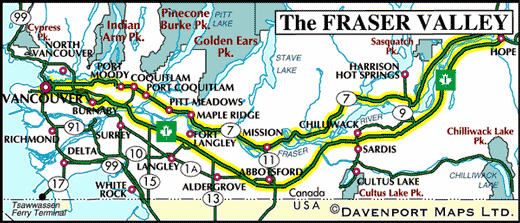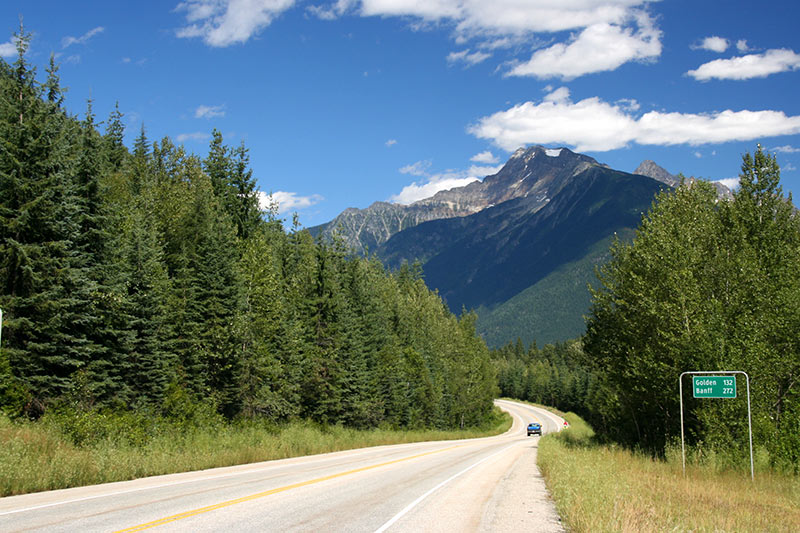The wide, fertile Fraser Valley is spread between the Coast and Cascade Mountains, parallel to the US-Canada border. The valley runs for more than a hundred miles inland from the Pacific Ocean to the small town of Hope at its eastern end. You can drive from one end of the Fraser Valley to the other in about two hours, but you can just as easily spend a lifetime exploring the 150 kilometres (93 miles) between Vancouver and Hope. Almost all of the fertile land is rural and supports a blend of farming, forestry, and outdoor recreation.
The Fraser River flows down the middle of the Fraser Valley and by the very nature of its broad, deep, muddy girth, forces road travellers to choose between its north or south side. Two major highways cut east-west routes through the Fraser Valley, and link Vancouver with Hope. Highway 7 (the Lougheed Highway, or Broadway, in Vancouver) traverses the North Fraser Valley parallel with the Fraser River. As Highway 1 (the Trans-Canada Highway) heads east of Vancouver, it crosses the Fraser River on the Port Mann Bridge and leads through the South Fraser Valley. Whereas Highway 1 is a divided freeway designed to deliver travellers to their destination as quickly as possible, in most places Highway 7 is a conventional roadway and doubles as the main street for the towns through which it passes.
Begin this scenic journey of the Fraser Valley by following Highway 7 along the north bank of the historic Fraser River. Visit Pitt Meadows and Maple Ridge, and enjoy the mild climate while teeing off on championship 18-hole golf courses amid rolling tranquil countryside, with views of mountain peaks and winding rivers.

Golden Ears Provincial Park in Maple Ridge is a destination with many possibilities, and is a popular camping venue. Once there, you can fan out through the park to explore on foot, by boat, by bike, or on horseback. Keep your camera handy! Pitt Lake, a superb location for paddlers searching for freshwater adventure, serves as the gateway to several wilderness areas. The Pitt-Wildlife Management Area is home to trumpeter swans, rare sandhill cranes, hawks, eagles, herons, ospreys, and other wildlife.
The Fraser winds along to Mission, which is tied historically to the Cariboo gold rush of the 1850s. There is still a strong Native presence in the region, and each year in July, the Mission Powwow draws drummers, singers, dancers, and spectators to a three-day festival.
Westminster Abbey, home to a Benedictine monastery, crows the skyline and occupies a ridge overlooking the Fraser River Valley. Kilby Historic Site is adjacent to Kilby Provincial Park– it’s well worth visiting. Look through the restored boarding house, post office, and general store to get a feel for life on the Fraser River at the turn of the century, when sternwheelers linked small towns like Harrison Mills with the docks downstream at Mission and New Westminster.
After a hectic day of sightseeing, visit Harrison Hot Springs. Called the “Spa of Canada,” Harrison Hot Springs is a resort town with recreation and health at the forefront. Take the airtram for breathtaking views of the Fraser River as it roars through this famous gorge. Continue along Hwy 1 to Hope, a pretty little town with great appeal for outdoor adventurers – Kawkawa Lake Park is nearby, as is Coquihalla Canyon Provincial Park. Not far away is E.C. Manning Provincial Park with more lakes and hiking trails. The local joke here is that no matter which way you are going, the rest of B.C. is “beyond Hope”.
Interesting spots for visitors to check out along the way include Minster Gardens, which feature 11 themed gardens, designed to dazzle the senses with fragrance and colour. Nestled at the base of Mount Cheam, Bridal Falls offers panoramic views of the Fraser Valley. The warm waters of Cultus Lake have attracted visitors to frolic and splash on its beaches for decades. The water is so clear, that at midday, the gold sand on the bottom on the lake perfectly complements the colour of the summer sun. All the amenities of beach life are found here: barbeques, a picnic gazebo, tennis courts, washroom facilities and even a boat rental are close at hand.
Continue West along Highway 1 through the lush Fraser Valley to Abbotsford, Langley, Fort Langley, and Surrey. Each town has its distinctive charm, history, colour characters to meet and things to do. The annual Abbotsford International Airshow, held in August, features aerial acrobatic teams, vintage aircraft and stunt flyers. Attracting 300,000 spectators, this is North America’s largest aerial extravaganza. Throughout British Columbia, several historic 19th-century forts have been preserved as reminders of how the west was originally settled by Europeans.
Fort Langley National Historic Site, a Hudson’s Bay Company post that has been preserved and restored, is open year-round. It, too, is a delightful reminder of yesteryear. Nearby is the Fort Langley Railway Museum, with a restored station from the 1920s era, a Canadian National Railway caboose, and an operating model railway. It’s well worth a visit as you explore the town in the vicinity of the fort.
Complete this scenic circle tour with a stop in Vancouver. To list even a portion of Vancouver’s attractions is impossible to do here. Suffice it to say, the real charm and advantage of Vancouver is the range of entertaining options open to visitors. Urbanites can eat at world-class restaurants, attend the symphony, shop at exclusive boutiques along Robonstrasse and never cast so much as a glance at the surrounding sea and skyscape. Those with an appreciation of the outdoors can windsurf in the morning, golf at lunch, ski at noon, and take in the city lights at night from atop a North Shore mountain. The city itself is clean, colourful and friendly, with a cosmopolitan vibrancy that Pacific West Coast cities are known for.
Approximate Distance: 2,000 Km
Approximate Duration: 7 to 14 days
Towns on or near this Route


